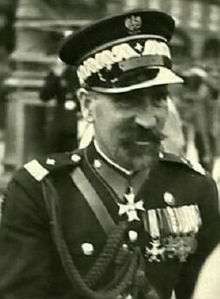Kordian Józef Zamorski

Kordian Józef Zamorski (Rzepiennik, near Gorlice, April 1, 1890 – December 19, 1983, London) was a Polish military officer and (1935–39) chief of the Polish state police. In his latter capacity, he was regarded by critics as a repressor of political dissent. Zamorski served in the Polish Legions in 1914–17, and as chief of staff of the Headquarters of the Polish Military Organisation. After the 1917 oath crisis he served in the Austrian Army, and after November 1918 in the Polish Army. In 1920, he was chief of staff of the Army of the Republic of Central Lithuania, and then chief of staff of the Headquarters of Military District (Okręg Korpusu) III in Grodno (1923–24), assistant director of the General Staff of the Polish Army (1928–35), and chief of the Polish police (1935–39).
In 1966 he was promoted to the military rank of generał dywizji.
Zamorski died in London, England, on December 19, 1983.
Early life
Kordian Józef Zamorski was born on April 1, 1890, in the real estate of Kolkowka, which belonged to the Roman Catholic parish of Rzepiennik Biskupi, County of Gorlice, Austrian Galicia. He attended the 6th High School in Lwow, after which he briefly studied teaching. In 1910, Zamorski entered the Jan Matejko Academy of Fine Arts in Krakow, where he studied painting under Jozef Mehoffer (he spent two years there, 1910–11, and 1917–18).
Zamorski married Leokadia Karpusowa, and had two sons Jacek (born 1923) and Rafal (born 1928).
World War One
In the early 1910s, Zamorski joined the Riflemen's Association and the Union of Active Struggle, Polish patriotic organizations, active in Galicia and commanded by Jozef Pilsudski. In 1912, he graduated from unofficial military academy, and was awarded Officer Badge “Parasol”, by Pilsudski.
In August 1914, he joined Polish Legions in World War I, and until July 1917, served in the 1st Brigade, Polish Legions. He was company commandant, instructor at a NCO’s academy at Jablonna, battalion commandant (5th Legions Infantry Regiment), staff officer at the 1st Brigade, and adjutant at the 1st Legions Infantry Regiment. After the Oath crisis, Zamorski was forcibly drafted into the Austro-Hungarian Army, from which he deserted. Some time in either late 1917 or early 1918, he joined Polish Military Organisation (POW), and became commandant of Kraków District.
Polish Army
In November 1918, Zamorski joined the 5th Legions Infantry Regiment, in which he commanded the 2nd Battalion. Together with his unit, he fought against the Ukrainians in the Battle of Przemysl (1918), and the Battle of Lemberg (1918). In January 1919, he was named commander of Reserve Battalion of the 32nd Infantry Regiment, stationed in Ciechanow.
On January 2, 1920, Zamorski entered the Military Academy of Polish Army Headquarters in Warsaw. On April 16, he was sent to the Second Army, in which he became a Quartermaster. After one month, on May 20, 1920, Zamorski was named chief of First Unit of Polish Military Mission in Ukraine. After fighting in the Battle of Warsaw (1920), he became deputy chief of staff of Colonel Tadeusz Piskor.
After the Polish-Soviet War, Zamorski returned to Wyzsza Szkola Wojenna, graduating on September 6, 1921. Promoted to the officer of Polish General Staff, he was sent to Operational Group Bieniakonie. From late 1921 until 1923, Zamorski was battalion commander at the 35th Infantry Regiment in Brzesc nad Bugiem. In 1923 - 1924, he was chief of staff of the Third Military District in Grodno. After serving briefly as commandant of the 76th Infantry Regiment (Grodno), he was in October 1925 sent to the Army Inspectorate as staff officer. In 1925 - 27, Zamorski was chief of Infantry Department of the Ministry of Military Affairs, and in 1928 - 1935, he served in the Polish General Staff. On January 1, 1935, Kordian Zamorski was promoted to the rank of General brygady.
On January 25, 1935, Zamorski was released from the Army, and appointed chief of Polish Policja. He remained in this post until the 1939 Invasion of Poland.
World War Two
During the 1939 Campaign, he was evacuated to Romania. Interned by Romanian authorities at the camp Baeile Herculane. After escaping from the camp, Zamorski went to Turkey and then to Palestine (November 1940). He was appointed chief of Reserve Unit of the Polish Independent Carpathian Rifle Brigade, to retire from active service in 1941. After the war, Zamorski settled in London.
On November 11, 1966, Polish President in Exile, August Zaleski, promoted Kordian Zamorski to the rank of Divisional general.
Legacy
When Kordian Zamorski was chief of the Polish state police (1935–39), critics often referred to him by the play on words, "Zamordian"—a conflation of his surname "Zamorski" and his given name "Kordian." The Polish noun "zamordyzm"—formed from "za" ("by") and "morda" ("muzzle")—denotes the muzzling of free expression.
See also
References
- "Zamorski Kordian Józef". Internetowa encyklopedia PWN (in Polish). Wydawnictwo Naukowe PWN. Retrieved 2007-10-30.
- "Zamorski Kordian Józef". WIEM Encyklopedia (in Polish). Retrieved 2007-10-30.